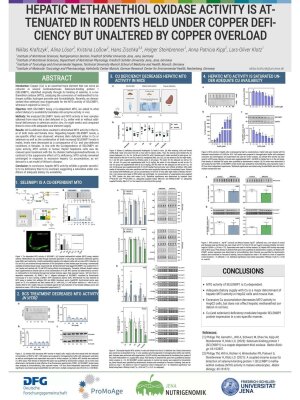
Poster Niklas Krafczyk
Grafik: Niklas KrafczykHEPATIC METHANETHIOL OXIDASE ACTIVITY IS AT-TENUATED IN RODENTS HELD UNDER COPPER DEFI-CIENCY BUT UNALTERED BY COPPER OVERLOAD
Niklas Krafczyk1, Alina Löser2, Kristina Loßow2, Hans Zischka3,4, Holger Steinbrenner1, Anna Patricia Kipp2, Lars-Oliver Klotz1
1Institute of Nutritional Sciences, Nutrigenomics Section, Friedrich Schiller University Jena, Jena, Germany
2Institute of Nutritional Sciences, Department of Nutritional Physiology, Friedrich Schiller University Jena, Jena, Germany
3Institute of Toxicology and Environmental Hygiene, Technical University Munich School of Medicine and Health, Munich, Germany
4Institute of Molecular Toxicology and Pharmacology, Helmholtz Center Munich, German Research Center for Environmental Health, Neuherberg, Germany
Abstract
Introduction: Copper (Cu) is an essential trace element that can serve as cofactor in several oxidoreductases. Selenium-binding protein 1 (SELENBP1), identified originally through its binding of selenite, is a me-thanethiol oxidase (MTO), catalyzing the conversion of methanethiol to hydrogen sulfide, hydrogen peroxide and formaldehyde. Recently, we demonstrated that selenium was dispensable for the MTO activity of SELENBP1, whereas it required Cu ions [1].
Objective: With SELENBP1 being a Cu-dependent MTO, we asked to what extent dietary Cu availability translates into enzyme activity in vivo.
Methods: We analyzed SELENBP1 levels and MTO activity in liver samples obtained from mice fed a diet deficient in Cu, either with or without additional deficiencies in selenium and/or zinc, for eight weeks and compared these to mice with adequate trace element supply.
Results: All Cu-deficient diets resulted in diminished MTO activity in the liver of both male and female mice. Regarding hepatic SELENBP1 levels, a sex-specific effect was observed: whereas diets deficient either in Cu or selenium as well as the combination of both increased SELENBP1 levels in males, levels were decreased as a consequence of Cu- and zinc-deficient conditions in females. In line with the Cu-dependence of SELENBP1 enzyme activity, MTO activity in human HepG2 hepatoma cells was decreased upon treatment with the Cu chelator bathocuproinedisulfonate. In contrast to the suppressive effect of Cu deficiency, MTO activity remained unchanged in response to excessive hepatic Cu accumulation, as evidenced in a rat model of Wilson’s disease.
Conclusion: In conclusion, hepatic MTO activity exhibits a greater sensitivity to Cu deficiency than to Cu overload, suggesting a saturation under conditions of adequate dietary Cu availability.
[1] Philipp TM, Gernoth L, Will A, Schwarz M, Ohse VA, Kipp AP, Steinbrenner H, Klotz LO. (2023): Selenium-binding protein 1 (SELENBP1) is a copper-dependent thiol oxidase. Redox Biology. 65:102807.
